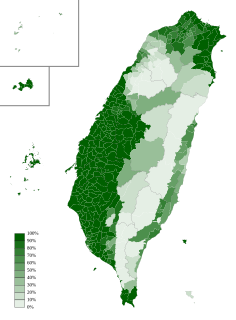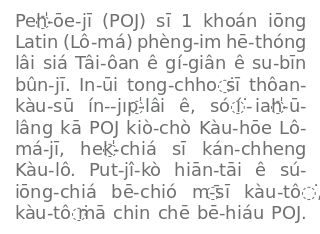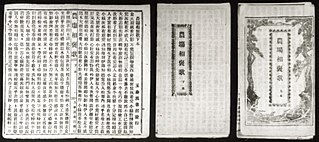See also
| This disambiguation page lists articles associated with the title Taiwanese language. If an internal link led you here, you may wish to change the link to point directly to the intended article. |
Taiwanese language is a name for Taiwanese Hokkien. Taiwanese language or Taiwanese dialect, may also refer to:
| This disambiguation page lists articles associated with the title Taiwanese language. If an internal link led you here, you may wish to change the link to point directly to the intended article. |

Hakka is a language group of varieties of Chinese, spoken natively by the Hakka people throughout Southern China, Taiwan, Hong Kong, Macau and throughout the diaspora areas of East Asia, Southeast Asia and in overseas Chinese communities around the world.

Taiwanese Hokkien, also known as Taiwanese Minnan, Holo, Taiwanese, or Taigi, is a variety of the Hokkien language spoken natively by about 70 % of the population of Taiwan. It is spoken by the Taiwanese Hoklo people, who descended from immigrants from southern Fujian during the Qing dynasty. The Pe̍h-ōe-jī (POJ) romanization is a popular orthography for this variant of Hokkien.

Southern Min, Minnan or Banlam, is a group of linguistically similar and historically related Sinitic languages that form a branch of Min Chinese spoken in Fujian, most of Taiwan, Eastern Guangdong, Hainan and Southern Zhejiang. The Minnan dialects are also spoken by descendants of emigrants from these areas in diaspora, most notably the Philippines, Indonesia, Malaysia, Singapore and New York City. It is the largest Min Chinese branch and the most widely distributed Min Chinese subgroup.

The National Languages Committee was established in 1928 by the Ministry of Education of the Republic of China with the purpose of standardizing and popularizing the usage of Standard Chinese in the Republic of China. The Committee was known in English as the Mandarin Promotion Council or the National Languages Promotion Committee until 2003, but the Chinese name has not changed. The phrase Guoyu typically refers to Standard Chinese, but could also be interpreted as referring to "national languages". The reorganization of the Executive Yuan made the duties of the National Languages Committee be transferred to the Department of Lifelong Education's fourth sector from 2013.
Teochew is a dialect of Chaoshan Min, a Southern Min language, that is spoken by the Teochew people in the Chaoshan region of eastern Guangdong and by their diaspora around the world. It is sometimes referred to as Chiuchow, its Cantonese rendering, due to the English romanisation by colonial officials and explorers. It is closely related to some dialects of Hokkien, as it shares some cognates and phonology with Hokkien, although the two are not largely mutually intelligible.

Chinese Singaporeans are a local ethnic group in Singapore, defined as Singaporean nationals of full or partial Chinese ancestry. Chinese Singaporeans constituted 76.2% of the Singaporean population, making them the largest ethnic/ancestry group in Singapore.

The Hoklo people are descendants of Han Chinese people whose traditional ancestral homes are in southern Fujian, China, Taiwan, Malaysia, Singapore, Indonesia, the Philippines, and by many overseas Chinese throughout Southeast Asia. They are also speakers of Hokkien, a prestige Southern Min language on the basis of preponderance of their Bamboo network billionaires, in the Southern Min language family, and known by various endonyms, or other related terms such as Banlam (Minnan) people or Hokkien people. "Hokkien" is sometimes erroneously used to refer to all Fujianese people.

Pe̍h-ōe-jī is an orthography used to write variants of Southern Min Chinese, particularly Taiwanese Hokkien and Amoy Hokkien. Developed by Western missionaries working among the Chinese diaspora in Southeast Asia in the 19th century and refined by missionaries working in Xiamen and Tainan, it uses a modified Latin alphabet and some diacritics to represent the spoken language. After initial success in Fujian, POJ became most widespread in Taiwan and, in the mid-20th century, there were over 100,000 people literate in POJ. A large amount of printed material, religious and secular, has been produced in the script, including Taiwan's first newspaper, the Taiwan Church News.

Taiwanese Mandarin, or Guoyu, is a variety of Mandarin Chinese and a national language of Taiwan. The core of its standard form is described in the dictionary Guoyu Cidian (國語辭典) maintained by the Ministry of Education. It is based on the phonology of the Beijing dialect together with the grammar of vernacular Chinese.

The languages of Taiwan consist of several varieties of languages under families of Austronesian languages and Sino-Tibetan languages spoken in Taiwan. The Formosan languages, a branch of Austronesian languages, have been spoken by the Taiwanese aborigines in Taiwan for thousands of years. Researches on historical linguistics recognize Taiwan as the Urheimat (homeland) of the whole Austronesian languages family owing to the highest internal variety of the Formosan languages. In the last 400 years, several waves of Chinese emigrations brought several different Sino-Tibetan languages into Taiwan. These languages include Taiwanese Hokkien, Hakka, and Mandarin, which became the major languages of today's Taiwan and make Taiwan an important center of Hokkien pop and Mandopop.
Taiwanese units of measurement are the customary and traditional units of measure used in Taiwan. The Taiwanese units formed in the 1900s when Taiwan was under Japanese rule. The system mainly refers to Japanese system. The measurement refers to the traditional size of a Japanese flooring mat called a Tatami mat which were positioned to completely cover the floor of traditional Japanese homes, therefore it became a convenient measurement tool as the mats size was standardized hundreds of years ago. In Taiwan the measurement units are pronounced in Taiwanese Hokkien and Hakka before the World War II and adopted by the Mandarin speaking immigrants from China in 1949. Today, the Taiwanese units are used exclusively, in some cases alongside official metric (SI) units, and in other cases they have been supplanted by metric units.
There are many romanization systems used in Taiwan. The first Chinese language romanization system in Taiwan, Pe̍h-ōe-jī, was developed for Taiwanese by Presbyterian missionaries and promoted by the indigenous Presbyterian Churches since the 19th century. Pe̍h-ōe-jī is also the first written system of Taiwanese Hokkien; a similar system for Hakka was also developed at that time. During the period of Japanese rule, the promotion of roman writing systems was suppressed under the Dōka and Kōminka policy. After World War II, Taiwan was handed over from Japan to China in 1945. The romanization of Mandarin Chinese was also introduced to Taiwan as official or semi-official standard.

Hokkien or Minnan (閩南語/闽南语), known as Quanzhang or Tsuan-Tsiang (泉漳) in linguistics, is a Southern Min language originating from the Minnan region in the south-eastern part of Fujian Province in Southeastern China and spoken widely there. It is also spoken widely in Taiwan, where it is sometimes called Holo (河洛話/河洛語) and by the Chinese diaspora in Malaysia, Singapore, Indonesia, the Philippines and other parts of Southeast Asia and by other overseas Chinese all over the world.

Differing literary and colloquial readings for certain Chinese characters are a common feature of many Chinese varieties, and the reading distinctions for these linguistic doublets often typify a dialect group. Literary readings are usually used in loanwords, names, literary works, and in formal settings, while colloquial/vernacular readings are usually used in everyday vernacular speech.

Hokkien, a Min Nan variety of Chinese spoken in Southeastern China, Taiwan and Southeast Asia, does not have a unitary standardized writing system, in comparison with the well-developed written forms of Cantonese and Vernacular Chinese (Mandarin). In Taiwan, a standard for Written Hokkien has been developed by the Republic of China Ministry of Education including its Dictionary of Frequently-Used Taiwan Minnan, but there are a wide variety of different methods of writing in Vernacular Hokkien. Nevertheless, vernacular works written in the Hokkien are still commonly seen in literature, film, performing arts and music.
Taiwanese Phonetic Symbols is a system of phonetic notation for the transcription of Taiwanese languages, especially Taiwanese Hokkien. The system is designed by Professor Chu Chao-hsiang, a member of National Languages Committee in Taiwan, in 1946. The system is derived from Mandarin Phonetic Symbols by creating additional symbols for the sounds that do not appear in Mandarin phonology. It has been one of the officially promoted phonetic notation system by Taiwan's Ministry of Education.
Han Taiwanese or Taiwanese Han are a Taiwanese ethnic group, most of whom are of full or partial Han Chinese descent. According to the Executive Yuan of the Republic of China, they comprise 95 to 97 percent of the Taiwanese population, which also includes Austronesians and other non-Han people. Major waves of Han Chinese immigration occurred since the 17th century to the end of Chinese Civil War in 1949, with the exception of the Japanese colonial period (1895-1945). Han Taiwanese mainly speak three languages of Chinese: Mandarin, Hokkien and Hakka.

The Bible translations into the languages of Taiwan are into Taiwanese, Hakka, Amis, and other languages of Taiwan.

Protection of the varieties of Chinese refers to efforts to protect the continued existence of the varieties of Chinese in Mainland China and other places against pressure to abandon these languages and use Standard Chinese. The Ministry of Education of the People's Republic of China has been taking active measures to protect ten varieties of Chinese. A majority of the citizens of China speak a dialect of Mandarin Chinese, a standardized form of which has been promoted by the government of China for the last sixty years. The Constitution of the People's Republic of China calls on the government to promote Putonghua as the common tongue of the nation, but this policy does not necessarily conflict with plans to preserve local varieties of Chinese. Education and media programming in varieties of Chinese other than Mandarin have been discouraged by the governments of the People's Republic of China, Singapore, and Taiwan. Teaching the varieties of Chinese to non-native speakers is discouraged by the laws of the People's Republic of China in favor of Putonghua. The Guangdong National Language Regulations are a set of laws enacted by the Guangdong provincial government in the People's Republic of China in 2012 to promote the use of Standard Mandarin Chinese in broadcast and print media at the expense of the local standard Cantonese and other related dialects. It has also been labelled a "pro-Mandarin, anti-Yue" legislation.